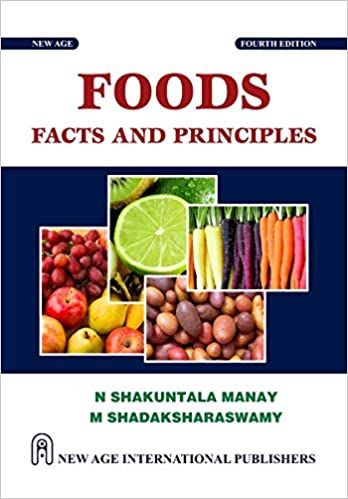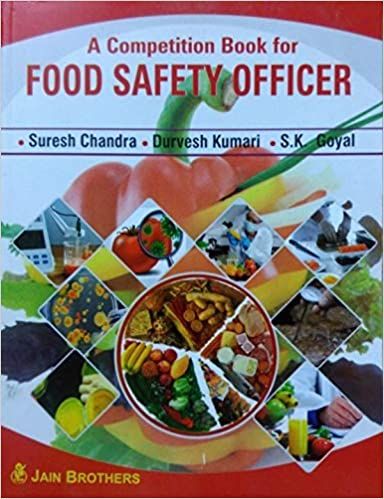1. Define Flavour.
Flavour is defined as the sensation perceived on eating a particular food mainly by the senses of taste and smell. The pain and temperature sensations also are helpful in perceiving the flavour of a food. Flavour is the sum of all the components that produce a sensation together. Flavour is a result of the interaction between the flavour compounds in foods and an individual’s taste and smell sensing mechanism.
2.List the five basic tastes and brief on the mechanism of taste sensation.
The five basic tastes are Sour, Salty, Bitter, Sweet and Umami. These tastes are mediated to the central nervous system through specialized taste receptor cells situated in the taste buds of the tongue. The taste buds are proportionally lesser in the palate and epiglottis region. The perception of a particular taste is the result of the pattern ofnerve activity arising from the numerous taste buds in the tongue. Further, the intensity of taste perceived is dependent on the type of papilla and the region of the tonguefrom where the sensation is derived.
3. Which components of food provide sweet, bitter and salty taste?
The components of food responsible for the sweet, bitter and salty taste are as follows:
a. Sweet taste is produced by compounds that have a hydroxyl, amine or methyl group. Examples: saccharides such as glucose, maltose, sucrose and sugar alcohols such as sorbitol and xylitol.
b. Inorganic salts such as potassium iodide, amino acids like leucine, arginine lead to bitter taste. Quinine, caffeine, theobromine are some of the alkaloids that taste bitter and are found in various foods and food products.
c. The common inorganic salts known to have a salty taste are sodium chloride with potassium chloride. Sodium chloride is commonly known as table salt and is the most predominant source of salt taste from the culinary aspect.
4. Which components of food provide sour and umami taste?
The food components responsible for providing sour and umami taste are as follows:
a. Sour taste:Commonly found acids such as tartaric acid, malic acid, citric acid and phosphoric acid. Buffers in foods can increase the sourness whereas alcohols can decrease the sourness in foods.
b. Umami taste: Free glutamates found in foods are responsible for umami taste. Examples of compounds include mono sodium glutamate, mono potassium glutamate, calcium glutamate and glutamic acid.
5. How can chemical structure influence of a compound influence the taste?
Taste and chemical structure are inter-related in producing taste which is more pronounced than smell alone. The sour taste of acids, salt taste of salts can undergo a change and become bitter as the atoms get bigger. Minor changes can occur by a change in the chemical structure for instance Saccharin whose sweetness reduces to half when a methyl group is introduced at para position in the cyclic ring structure. The taste of amino acids change with their configuration with sweet taste in the D form and bitter taste in the L form.Thus chemical structure can have a prominent influence on taste of a food.
6. How is odour perceived?
The odour of a food is perceived by the specialized type of cells called as olfactory cells. These cells are found on each side of the septum in the upper nasal cavity. The sensitive hairs within the nasal cavity communicate with the brain upon stimulation by food componentswithodour that pass through the nasal cavity.This interplay of the sensory system results inthe perception of flavour.
7. How are food flavours described? Write on the importance of flavour description?
Food flavours are described using primary, secondary and tertiary words for each flavour. For example, juicy, sweet, peely and other adjective words are used to describe the flavour of an orange. The description of food flavour is of importance in development of new food products as improperly described or identified flavours lead to undesirable nature of the end product.The precise description of food flavours is of value in training the sensory panel members to recognize the flavour of a food.
8.What is the difference between flavour enhancers and flavourings?
Flavour enhancers are used to enhance or increase the basic flavour already present in food whereas flavourings are added to foods in order to add or modify and existing flavour. The additives used for flavour in foods are of natural and synthetic origin. They are added to foods to provide flavour either partially or completely and are mainly used to replace the losses that can happen during various stage of processing.
9. Write a note on E-number used to identify the flavour enhancers with examples.
E- number is a code used to number the permitted flavour enhancers for use in food processing. The E numbers are used within the European Union and Switzerland. This numbering system is practiced with an aim to ensure the use of authorized and safe use of additives to foods. E number can be found in the ‘ingredients used’ section in the food labelling. TheE-numbers of the flavour enhancers mono sodium glutamate, maltol, inosinic acid is E621,E636 and E630 respectively.
10. How are flavourings classified?
The flavourings are classified based on their origin into the following three categories:-
a. Natural flavourings obtained from plant or animal source by physical or chemical methods. Ex: spices, herbs etc
b. Nature identical flavourings obtained by extraction of compounds with identical structure and properties as a natural flavouring. Ex: Vanillin
c. Artificial flavourings that are synthetically produced by chemical processes with no equivalence in nature. Ex: Ethyl Vanillin
11. What are the primary, secondary and tertiary words used to describe flavour of Lemon, Apple and Grape?
The words used to describe the flavour for lemon, apple and grape are as follows:-
a. Lemon- The primary word used is lemon and the secondary/tertiary words used are Juicy, Fresh, Peely, Oxidized, Oily and Candy.
b. Apple - The primary word used is apple and the secondary/tertiary words used are Red, Green,Peely, Juicy, Delicious, Fresh and Ripe.
c. Grape - The primary word used is grape and the secondary/tertiary words used are Concord, Muscat, Honey Floral, Herbal, Perfumed and Caramelized.
12. How are visual appearance, texture and flavour related?
Apart from taste and odour, the visual appearance and texture can affect the flavour of a food. The visual appearance of a food drives the decision to accept or reject a food and with experience the odour, taste and texture of a food can be predicted based on the experience. Appearance is dependent on the presentation of a food and properties like gloss, translucency and physical form. The primary textural aspects such as hardness, cohesiveness, viscosity, elasticity and secondary textural aspects such as chewiness, brittleness and gumminess have an impact on the acceptability and taste of a food. The ‘mouthfeel’ of a food is dependent on all these aspects.
13. List any five commonly used chemicals as food flavourings along with their flavour.
Five among the commonly used food flavourings are:-
a) Allylpyrazine – roasted nut flavour
b) Terpenoids – Citrus flavour
c) Alehydes – Fruity flavour
d) 2-Isobutyl-3-methoxypyrazine – Capsicum flavour
e) Acetyl-l-pyrazine – popcorn flavour








